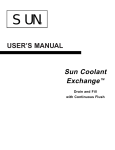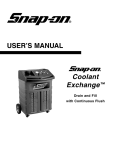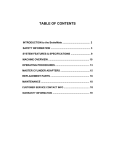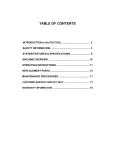Download here
Transcript
Safety Information Safety Notice For your safety, read this manual thoroughly before operating your DF1000™ unit. Your DF1000™ unit is intended for use by properly trained, skilled professional automotive technicians. The safety messages presented below and throughout this user's manual are reminders to the operator to exercise care when using this unit. There are many variations in procedures, techniques, tools, and parts for servicing vehicles, as well as in the skill of the individual doing the work. Because of the vast number of test applications and variations in the products that can be serviced with this instrument, White Industries® cannot possibly anticipate or provide advice or safety messages to cover every situation. It is the automotive technicians responsibility to be knowledgeable of the system that is to be tested. It is essential to use proper service methods and test procedures and to perform tests in an appropriate and acceptable manner that does not endanger your safety, the safety of others in the work area, the vehicle or equipment being tested. It is assumed that the operator has a thorough understanding of vehicle cooling systems before using the DF1000™ unit. This understanding of principles and operating theories is necessary for competent, safe and accurate use of this instrument. Before using your DF1000™ unit, always refer to and follow the safety messages and applicable test procedures provided by the manufacturer of the vehicle or equipment being tested. Read All Instructions Read, understand and follow all safety messages and instructions in this manual. Safety messages in this section of the manual contain a signal word with a three-part message and, in some instances, an icon. I Safety Information The signal word indicates the level of the hazard in a situation. • DANGER indicates an imminently hazardous situation which, if not avoided, will result in death or serious injury to the operator or bystanders. • WARNING indicates a potentially hazardous situation which, if not avoided, could result in death or serious injury to the operator or bystanders. • CAUTION indicates a potentially hazardous situation which, if not avoided, may result in moderate or minor injury to the operator or bystanders. • IMPORTANT indicates a situation which, if not avoided, may result in damage to the equipment or vehicle. Safety messages in this section contain three different type styles. • Normal type states the hazard. • Bold type states how to avoid the hazard. • Italic type states the possible consequences of not avoiding the hazard. An icon, when present, gives a graphical description of the potential hazard. IMPORTANT SAFETY INSTRUCTIONS General Risk of fire. • Wear safety goggles and protective gloves, user and bystander. Everyday eyeglasses only have impact resistant lenses, they are NOT safety glasses. • Do not position head directly over or in front of carburetor or throttle body. Engine backfire can occur when air cleaner is out of normal position. • Keep a dry chemical (Class B) fire extinguisher rated for gasoline, chemical electrical fires in the work area. Fire can cause death or serious injury. II Safety Information Risk of entanglement. • Do not place test equipment or tools on fenders or other places in engine compartment. • Keep yourself, clothing and tester leads clear of moving parts such as fan blades, pulleys, hood and doors. • Barriers are recommended to help identify danger zones in test area. • Prevent personnel from walking through immediate test area. Contact with moving parts can cause injury. Risk of expelling fuel, oil vapors, hot steam, hot toxic exhaust gases and other debris. • Wear safety goggles and protective clothing, user and bystander. • Engine systems can malfunction expelling fuel, oil vapors, hot steam, hot toxic exhaust gases and other debris. Fuel, oil vapors, hot steam, hot toxic exhaust gases, and other debris can cause serious injury. Risk of burns. • Do not remove radiator cap unless engine is cold. • Pressurized engine coolant may be hot. Burns can cause injury. Risk of burns. • Do not touch hot exhaust systems, manifolds, engines, radiators, etc. • Wear gloves when handling hot engine components. Hot components can cause injury. Risk of unexpected vehicle movement. • Block drive wheels before performing a test with engine running. • Unless instructed otherwise, set parking brake and put gear selector in neutral for standard transmissions or park for automatic transmissions. • If vehicle has an automatic parking brake release, disconnect release mechanism for testing and reconnect when testing is completed. • Do not leave a running engine unattended. A moving vehicle can cause injury. III Safety Information Misdiagnosis may lead to incorrect or improper repair and/or adjustment. Do not rely on erratic, questionable, or obviously erroneous test information or results. If test information or results are erratic, questionable, or obviously erroneous, make sure that all connections and data entry information are correct and that the test procedure was performed correctly. If test information or results are still suspicious, do not use them for diagnosis. Contact White Industries® customer services. Improper repair and/or adjustment may cause vehicle or equipment damage or unsafe operation. Risk of flying particles. • Wear safety goggles user and bystander. Rotating engine parts can cause flying particles. • Make sure gauge reads zero before connecting or disconnecting hose connections to adapters. • Make sure cooling system pressure has been relieved before connecting or disconnecting hose connections and adapters. • Make sure gauge reads zero before removing supply tank cap. Flying particles can cause eye injury. SAVE THESE INSTRUCTIONS IV Table of Contents Safety .................................................................................................................... I Introduction ........................................................................................................ 1-1 Functional Description ...................................................................................................... Front Panel .................................................................................................................. Back Panel .................................................................................................................. Control Panel .............................................................................................................. Accessories ................................................................................................................ Key Terms .................................................................................................................. Specifications .................................................................................................................... 1-1 1-1 1-2 1-3 1-4 1-5 1-6 Installation and Operation ................................................................................ 2-1 Testing Tips ................................................................................................................ 2-1 Valve Position Chart .......................................................................................................... 2-2 Preparing Vehicle for Service ............................................................................................ 2-4 Pressure Test .................................................................................................................... 2-4 Drain and Fill .................................................................................................................... 2-7 Power Drain Recovery Tank ............................................................................................ 2-10 Recycle Used Coolant from Recovery Tank .................................................................... 2-11 Maintenance ...................................................................................................... 3-1 Cleaning Recovery Hose Strainer ...................................................................................... Troubleshooting ................................................................................................................ Replacement Parts ............................................................................................................ Optional Accessories ........................................................................................................ 3-1 3-2 3-3 3-3 i Table of Contents ii Table of Illustrations Introduction Figure Figure Figure Figure 1-1: 1-2: 1-3: 1-4: Front Panel .................................................................................................... Back Panel .................................................................................................... Control Panel ................................................................................................ DF1000™ Accessories .................................................................................. 1-1 1-2 1-3 1-4 Installation and Operation Figure 2-1: Recovery Hose and Adapter Attached to Radiator .......................................... 2-5 Figure 2-2: Supply Hose and Adapter Attached to Engine ................................................ 2-5 Table 2-1: Cooling System Pressure Ranges .................................................................... 2-7 Maintenance Figure 3-1: Strainer Assembly .......................................................................................... 3-1 iii Table of Illustrations iv Using this Manual This manual contains instructions for use and setup of your DF1000™ unit. A table of contents and table of illustrations are provided to make this manual easy to use. Some of the information shown in text or illustrations is obtained using optional equipment. Conventions This section contains a list of conventions used in text. Check Note A check note provides additional information about the subject in the preceding paragraph. Example: ✓ A pulsating recovery hose (red) is a normal condition while draining. Equipment Tips Equipment tips provide information that applies to specific equipment. Each tip is introduced by this icon ❐ for easy identification. Example: ❐ When servicing coolant systems, the coolant in the overflow bottle should also be removed. Use the suction wand to remove the coolant. v Using this Manual Safety Messages Safety messages are provided to help prevent personal injury and equipment damage. All safety messages are introduced by a signal word indicating the hazard level. The types of safety messages are: Indicates an imminently hazardous situation which, if not avoided, will result in death or serious injury to the operator or to bystanders. Indicates a potentially hazardous situation which, if not avoided, could result in death or serious injury to the operator or to bystanders. Indicates a potentially hazardous situation which, if not avoided, may result in moderate or minor injury to the operator or to bystanders. Some safety messages also contain visual symbols with signal words. Example: Engine systems can malfunction expelling fuel, oil vapors, hot steam, hot toxic exhaust gases, acid, refrigerant and other debris. Wear safety goggles and protective gloves, user and bystander. Everyday eyeglasses only have impact resistant lenses, they are NOT safety glasses. Engine systems that malfunction can cause injury. vi 1 Introduction The White DF1000™ unit, part number EESE504A, is a device that removes and refills engine coolant and also pressure tests the cooling system. Coolant is extracted and refilled through the upper radiator hose connection without the vehicle engine running. Before coolant refill, a vacuum is applied to the cooling system to eliminate any air in the system. Functional Description Front Panel Figure 1-1: Front Panel A — Supply Tank Fill Port Filler neck for supply tank reservoir. B — Supply Tank Sight Tube Sight tube used to determine level of fresh coolant in supply tank. 1-1 Introduction C — Recovery Tank Sight Tube Sight tube used to determine level of used coolant in recovery tank. D — Control Panel Houses air regulator valve, pressure gauge and control valves A and B. E — Tray Use for tool and adapter storage. Back Panel Figure 1-2: Back Panel A — Supply Tank Hose (blue) and Valve B — Recovery Tank Hose (red) and Valve C — Recovery Hose Strainer Strainer used to filter large contaminants from recovered coolant. D — Power Drain Hose and Valve Used for draining of recovery tank. E — Air Inlet Valve Switches shop air supply ON or OFF. 1-2 Introduction Control Panel Figure 1-3: Control Panel A — Air Pressure/Vacuum Gauge Used to monitor pressure and vacuum applied to cooling system. B — Air Regulator Valve Used to regulate air pressure applied to cooling system. C — Control Valve A Switches the DF1000™ unit between PRESSURE, HOLD, and FILL/FLUSH operations. D — Control Valve B Switches the DF1000™ unit between DRAIN and FILL, and DRAIN RECOVERY TANK operations. 1-3 Introduction Accessories Figure 1-4: DF1000™ Accessories A — Suction Wand Used to extract coolant from radiator or surge tank to lower coolant level. B — Hose Pinch Pliers Small, medium and large pliers. Used to pinch-off hoses. C — Multi-size Hoses and Adapters Used to connect recovery (red) and supply (blue) hoses to the vehicle cooling system. Adapters sizes are 1-1/4, 1-3/8, 1-1/2, and 1-3/4. 1-4 Introduction Key Terms Use the following definitions for a description of control panel figures. REGULATOR Changes the air pressure setting higher or lower. HOLD The supply hose (blue) is closed to allow a vacuum to evacuate the remainder of the coolant in the cooling system. PRESSURE Air pressure is applied to the supply hose (blue) to assist in cooling system draining and pressure testing. FILL New coolant from the supply tank is directed through the supply hose (blue) to fill the cooling system. DRAIN and FILL The unit is in the DRAIN and FILL mode. DRAIN RECOVERY TANK The unit is in the DRAIN RECOVERY TANK mode. 1-5 Introduction Specifications Dimensions Height 41.5” Width 33” Weight 123 lbs (tanks empty) Power Compressed shop air 90 PSI Operating Temperature 0° to 120°F (-17.8° to 48.9°C) Storage Temperature -4° to 150°F (-20° to 65.5°C) 1-6 Depth 25.75” 2 Installation and Operation Testing Tips ❐ When servicing coolant systems, the coolant in the overflow bottle should also be removed. Use the suction wand to remove the coolant. ❐ When performing a Pressure Test, if coolant seeps into the overflow bottle before the system is at the pressure specified on the radiator cap, the pressure relief valve is bad and the radiator cap needs to be replaced. ❐ DO NOT OVER FILL THE SYSTEM. ❐ Normal expansion rate for coolant is 4-7%. Fill overflow bottle after the engine reaches normal operating temperature to assure system will not be overfilled. An overfilled system will expel any additional coolant during normal system expansion. ❐ When looking for coolant leaks: — Check all hose connections prior to, in operation, and after all tests are performed. — Check heater core, water pump*, thermostat housing, freeze plugs, and radiator for any visible leaks. * Water pumps are sometimes located under timing belt covers. — If leaks are evident, but no visible leaks are found, check the internal engine. The leak may be from a cracked head, head gasket, intake, etc. 2-1 Installation and Operation Valve Position Chart Refer to this quick reference for correct valve positions during operations. Valve A Valve B Supply Hose Valve Recovery Hose Valve CLOSED OPEN PRESSURE APPLY TEST OPEN CLOSED PRESSURE HOLD TEST OPEN CLOSED DRAIN OPEN OPEN EVACUATE OPEN OPEN SUCTION WAND 2-2 Installation and Operation Valve A Supply Hose Valve Recovery Hose Valve HOLD OPEN CLOSED FILL OPEN CLOSED FLUSH OPEN OPEN CLOSED CLOSED OPEN CLOSED DRAIN RECOVERY TANK TOP OFF COOLING SYSTEM ✓ Valve B Drain Recovery Tank hose valve must be closed during all operations except, Drain Recovery Tank. 2-3 Installation and Operation Preparing Vehicle for Service Engine cooling systems run at high temperatures and pressures. Allow coolant system to cool before attempting service. ✓ Pressurized engine coolant may be hot and cause injury. 1. Remove radiator or surge tank cap after coolant system has cooled. Pressure Test Perform a pressure test on vehicle cooling system before draining or refilling the system. Follow this procedure to pressure test the cooling system. Refer to Valve Position Chart in this chapter for proper valve positioning during operations. 1. Follow the steps in Preparing Vehicle for Service. 2. Close all hose valves and air supply valve on the DF1000™ unit. 3. Turn Valve A to the left, pointing to the DRAIN position. 4. Turn Valve B up, pointing to the DRAIN and FILL position. 5. Connect shop air to the DF1000™ unit and turn air regulator knob counterclockwise until it stops. 6. Attach suction wand to the recovery hose (red). 7. Open air supply valve and recovery hose (red) valve. 8. Use suction wand to extract coolant from radiator or surge tank until coolant level is below upper radiator hose port. 9. Close recovery hose (red) valve. — Close air supply valve if desired to reduce noise. 10. Disconnect upper radiator hose from radiator, thermostat housing, or intake manifold. 11. Connect recovery hose (red) and adapter to radiator side of disconnected radiator or hose, refer to fig. 2-1. 2-4 Installation and Operation Figure 2-1: Recovery Hose and Adapter Attached to Radiator 12. Connect supply hose (blue) and adapter to engine side of disconnected radiator hose, refer to fig. 2-2. Figure 2-2: Supply Hose and Adapter Attached to Engine 13. Replace radiator or surge tank cap. 14. Open air supply valve and supply hose (blue) valve. — Make sure recovery hose (red) valve remains closed. 15. SLOWLY turn the air regulator knob clockwise until gauge pressure reaches the cooling system pressure rating. — Cooling system pressure rating can be found on radiator cap, or verify rating in owner’s manual or factory repair manual. 16. Turn Valve A to HOLD position when gauge reads the specified pressure and inspect cooling system for leaks. 2-5 Installation and Operation If Leak is Found 1. Close air supply valve. 2. Position Valve A to the left, pointing to the PRESSURE position. 3. Close supply hose (blue) valve when gauge reads zero. 4. Drain coolant from vehicle cooling system using the DF1000™ unit, refer to Drain and Fill in this chapter without performing the Fill portion. 5. Disconnect the DF1000™ unit from the vehicle and repair leak. 6. After leaks are repaired, repeat Pressure Test. If No Leaks are Found but Pressure Gauge Drops 1. Observe pressure gauge. 2. Pressure should not drop below pressure indicated in Table 2-1 after 1 minute. — No pressure drop, proceed to Drain and Fill in this chapter. 3. If pressure drops, check radiator or surge tank cap for inadequate holding capacity. — If air or coolant is venting into overflow reservoir or out of the surge tank at pressures below those specified in Table 2-1, replace the radiator or surge tank cap. 4. If pressure drops and radiator or surge tank cap is okay, a leaky head gasket or other internal engine problem may exist. — Consult factory service and diagnosis procedures for vehicle cooling system. 5. Disconnect the DF1000™ unit from the vehicle and repair leak. 6. After leaks are repaired, repeat Pressure Test. 2-6 Installation and Operation If No Leaks are Found and Pressure Gauge is Stable 1. Pressure test is complete. 2. Close air supply valve. 3. Turn Valve A to the left, pointing to the DRAIN position. 4. Perform Drain and Fill if desired. Radiator or Surge Cap Pressure Ranges 4 PSI Cap 7 PSI Cap 10 PSI Cap 13 or 14 PSI Cap 15 or 16 PSI Cap 18 PSI Cap 20 PSI Cap 30 PSI Cap 3-5 lbs 6-8 lbs 9-11 lbs 12-16 lbs 14-18 lbs 16-20 lbs 18-22 lbs 28-30 lbs Subtract one lb from lbs reading for used caps. e.g.: 15 or 16 PSI Cap would be 13-18 lbs. Table 2-1: Cooling System Pressure Ranges Drain and Fill Conventional Thermostat Location Follow this procedure to drain and fill the cooling system. 1. Verify recovery tank of the DF1000™ unit is not full and there is enough room left to complete a Drain and Fill process. 2. Verify supply tank level of the DF1000™ unit is adequate enough to complete a Drain and Fill process. 3. Pinch off overflow hose between radiator neck and overflow reservoir with supplied hose pinch pliers. ✓ On vehicles with a heater hose connected to the radiator, pinch off heater hose also. — Use two or three hose pinch pliers to pinch off hoses connected to surge tank, including the overflow hose connected to the surge tank neck, if applicable. 4. Make sure all hose valves are closed. 5. Make sure adapters and hoses are connected to vehicle as described in Pressure Test in this chapter. 2-7 Installation and Operation 6. Turn Valve A to the left, pointing to the DRAIN position. 7. Turn Valve B up, pointing to the DRAIN and FILL position. 8. Open air supply valve. 9. Adjust air regulator to 8-12 PSI. 10. Open supply (blue) and recovery hose (red) valves and observe old coolant flowing through the recovery hose (red) into the recovery tank. ✓ A pulsating recovery hose (red) is a normal condition while draining. 11. Turn Valve A clockwise to HOLD position when stream of old coolant is replaced by the flow of air. ✓ Cooling system hoses will collapse. 12. When vacuum gauge reading reaches 13-17 in. Hg., close recovery hose (red) valve. — Gauge should not deviate from 13-17 in. Hg. If gauge reading drops, check system for leaks. — In some instances the vacuum gauge reading will not reach 13-17 in. Hg. due to the upper or lower radiator hose collapsing. If this occurs continue to step 13. 13. Turn Valve A clockwise to FILL position. A rush of new coolant will pass through the supply hose (blue) and into vehicle’s cooling system. 14. When gauge reads 8-12 PSI, open recovery hose (red) valve to allow more old coolant to flow out of vehicle cooling system. 15. Close recovery hose (red) valve when coolant flow through recovery hose (red) turns from old to new coolant. ✓ Wait for cooling system hoses to fully expand before continuing. 16. Close supply hose (blue) and air supply valves. 17. When gauge reads zero, open recovery (red) and supply hose (blue) valves. — This will relieve pressure within cooling system and remove a small amount of coolant so radiator cap, if applicable, can be removed with minimal spillage. 2-8 Installation and Operation 18. Close recovery (red) and supply hose (blue) valves. 19. Remove recovery (red) and supply hose (blue) quick couplers from adapters. ✓ If coolant is still present in the adapters: — Reinstall quick couplers on adapters. — Open air supply valve. — Open recovery hose (red) valve long enough to allow a small amount of coolant to be removed from the system, then close valve. — On vehicles with radiator caps, remove cap to determine coolant level in radiator. When coolant level is low enough, adapters can be removed with minimal spillage. — On vehicles with surge tanks, open recovery hose (red) valve for about 2 seconds to bring coolant level low enough to remove adapters with minimal spillage. 20. Close air supply valve. 21. Reinstall upper radiator hose. 22. Remove radiator or surge tank cap. 23. Remove all hose pinch pliers from hoses. 24. Fill overflow reservoir or surge tank with new coolant to proper level. 25. Top off radiator with new coolant, if applicable. The supply hose (blue) can be used with the suction wand to top off the cooling system. To fill: — Connect suction wand to end of supply hose (blue). — Turn Valve A to the FILL position. — Open air supply and supply hose (blue) valves. 26. Reinstall radiator or surge tank cap. ✓ If cooling system contains a bleed screw or cap, follow manufacturer’s instructions to ensure the system is properly purged of air. 27. Start vehicle engine and allow it to run until it reaches normal operating temperature and the thermostat has opened. — Verify vehicle’s heat is operating properly while engine is running. 2-9 Installation and Operation Alternate Thermostat Location On some vehicles the thermostat is located at the point where the lower radiator hose is connected to the engine. 1. These applications may require connecting recovery hose (red) to the engine side and the supply hose (blue) to the radiator side of the upper radiator hose. 2. If insufficient coolant flow is observed in the recovery hose (red) during drain cycle: — Close air supply valve, — Wait for gauge to read zero, — Close hose valves and disconnect hoses from adapters, — Reverse connection of hoses on adapters, and — Continue Drain and Fill process. Power Drain Recovery Tank The recovery tank needs to be drained when full. Shop air is diverted to the recovery tank to assist the draining process. Follow these steps to drain the recovery tank. 1. Close all hose valves on the DF1000™ unit. 2. Turn Valve A to the left, pointing to the PRESSURE position. 3. Turn Valve B down, pointing to the DRAIN RECOVERY TANK position. 4. Connect shop air to the DF1000™ unit and adjust air regulator valve to achieve 8-12 PSI. 5. Open drain hose valve and drain used coolant. ✓ 2-10 Properly dispose or recycle used coolant. Installation and Operation Recycle Used Coolant from Recovery Tank Used coolant in the recovery tank can be filtered using the optional Drain and Fill Add-on Recycler kit part number EAK0239L01A, (see a White Industries® dealer for details). If the optional recycler kit is installed, follow these steps to recycle coolant. 1. Close all hose valves on the DF1000™ unit. 2. Turn Valve A to the left, pointing to the DRAIN position. 3. Turn Valve B down, pointing to the DRAIN RECOVERY TANK position. 4. Remove supply tank fill cap if recycled coolant is to be directed to the supply tank. 5. Connect shop air to the DF1000™ unit and adjust air regulator valve to achieve 8-12 PSI. 6. Turn manual valve on recycler kit to the RECYCLE position. 7. Position end of drain hose to direct filtered coolant into the supply tank or other coolant collection container. 8. Open drain hose valve and drain filtered coolant. ✓ Add proper additives to the filtered coolant. 2-11 Installation and Operation 2-12 3 Maintenance Use this chapter to maintain the DF1000™ unit. ✓ Troubleshooting information and a list of parts and accessories are also included. Cleaning Recovery Hose Strainer The recovery hose strainer needs to be cleaned after every Drain and Fill operation. Follow this procedure to clean the strainer. 1. Unscrew strainer bowl from housing. ✓ Be careful not to lose rubber bowl gasket. 2. Remove strainer screen and clean with running water and/or wipe clean with a shop towel. ✓ Be careful not to deform strainer screen. 3. Clean rubber gasket if necessary. 4. Re-install strainer screen, rubber gasket and strainer bowl. Strainer bowl should be installed onto housing finger tight. ✓ Do not overtighten strainer bowl. Figure 3-1: Strainer Assembly 3-1 Maintenance Troubleshooting Symptom Machine does not work, works very slow, or gauge pressure does not reach desired reading Gauge does not reach desired vacuum during evacuation cycle Machine drains very little or no coolant during drain cycle Machine does not completely fill cooling system with new coolant 3-2 Possible Cause Remedy • Low or no shop air pressure — Check shop air pressure • Shop air not connected to machine — Connect shop air hose to air supply valve • Leaky hose or connection — Check shop air and the DF1000™ hose connections and fittings • Supply tank fill cap off or not tight — Install or tighten filler cap • Low shop air pressure — Check shop air pressure • Hose(s) not pinched off on surge tank or overflow tank — Check all hoses connected to surge tank and/or overflow are pinched off • Leaky hose or connection — Check shop air, hose connections, and fittings • Recovery tank full (Check valve on recovery tank closed, shutting off vacuum to recovery tank and hose) — Drain recovery tank (refer to Power Drain Recovery Tank) • Recovery and supply hose connections reversed — Reverse recovery and supply hose connections (refer to Drain and Fill) • Recovery hose strainer is blocked with debris — Clean strainer (refer to Cleaning Recovery Hose Strainer) • Supply tank level too low before — Add coolant to supply starting drain and fill process tank and repeat fill cycle Maintenance Replacement Parts Part Number Description EAA0196L47AR .............................. Suction Wand Assembly EAA0195L26AR.......................... Radiator Adapter Assembly 1-1/4” to 1-3/8” EAA0195L27AR.......................... Radiator Adapter Assembly 1-1/2” to 1-3/4” 8-850.............................................. Hose Pinch Pliers, Large 8-950 .......................................... Hose Pinch Pliers, Medium 8-1150 ............................................ Hose Pinch Pliers, Small 5-4835-030 ...................... Rubber Coolant Hose, 1-1/4” I.D. 5-4935-030 ...................... Rubber Coolant Hose, 1-3/8” I.D. 5-5035-030 ...................... Rubber Coolant Hose, 1-1/2” I.D. 5-5135-030 ...................... Rubber Coolant Hose, 1-3/4” I.D. Optional Accessories EAK0239L01A .................................... Drain and Fill Add-on Recycler Option Kit 3-3 Maintenance 3-4










































